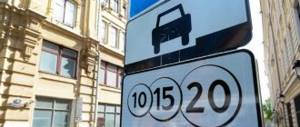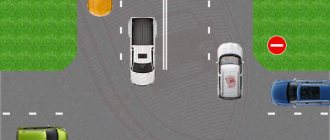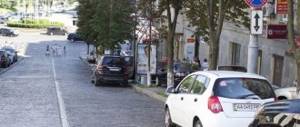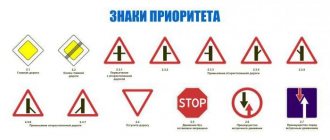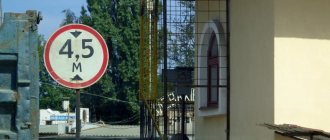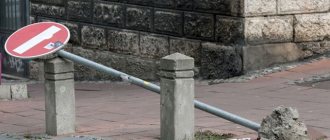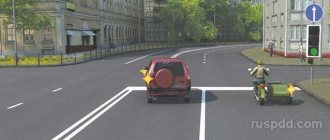“What were you fined for? I drove onto a brick!” - such or similar dialogues can often be heard from drivers, especially if they do not have much driving experience. And everything seems to be obvious: there is a “Brick” sign, it prohibits entry into the territory it is closing, and violation of this requirement leads to a fine.
The greater the surprise of motorists when it turns out that in some conditions they are fined for a relatively small amount of 500 rubles for this sign, and in others they are deprived of their rights. Moreover, there are cases when entry under the “Brick” is possible without any sanctions at all, and will not constitute a violation. We’ll talk about all the details of driving under sign 3.1 “No Entry” in this article.
- Is it possible to pass by public transport?
- When is it installed?
What does the “Brick” sign mean in the traffic rules?
Let’s say right away that “Brick” is an unofficial, one might say popular name for sign 3.1, which is correctly called “No Entry”. However, this colloquial form has become so firmly established in everyday life that it is easily used at all levels - from drivers to traffic police officers and/or judges.
And yet, according to the rules:
Sign 3.1 “Entry prohibited” - prohibits the entry of any vehicle in the direction blocked by this road sign.
Some of the difficulties are already concentrated in this formulation. Are the concepts of “entry” and “travel” different? Why is it stated that the sign applies to all vehicles, if previously it was said that it was possible to drive under the sign with impunity? We'll tell you about all this in due time. For now, let's return to the sign itself.
What does road sign 3.1 “No Entry” look like?
“No Entry” is a round red prohibitory sign with a white rectangle horizontally located in the center of the sign. Actually, this rectangle became the reason to call the sign “Brick”.
See the picture of the sign below.
What does the “brick” sign prohibit?
First of all, let’s look at the description of sign 3.1 “entry prohibited” from the section prohibiting signs of the traffic rules:
3.1 "No entry". Entry of all vehicles in this direction is prohibited.
This sign prohibits the movement of vehicles in one direction . That is, you cannot enter the selected section of the road only from the side of the “brick” sign.
It is important to understand that movement in the opposite direction is most often permitted. That is, a driver driving under a brick must be prepared for other cars to drive right into his head.
In addition, movement is prohibited for all vehicles, that is, not only cars, but also buses, trucks, motorcycles, mopeds, bicycles, etc.
In what cases is a sign installed and what does it mean?
Failure to comply with traffic rules is a fairly common occurrence on the roads of both large and small cities.
In addition to the fact that such actions are a direct violation of current legislation, they can also lead to accidents and road incidents that threaten the life and health of people.
Sign 3.1 “entry prohibited” is a graphic image in the form of a white rectangle located on a red background. Due to its appearance, this sign has received the unspoken and more common name “brick”.
This sign completely prohibits the passage of a vehicle into the area where it is installed. If it is used with signs indicating the direction of movement, then in this case the entry of cars is prohibited in these directions.
We can highlight specific cases in which this sign is installed:
- On one-way roads - in this case, a sign is needed to prohibit the passage of a car in the opposite direction. If there are several lanes on the road, this sign must be installed on each of them.
- On roads intended for traffic only by route vehicles - a sign is needed to prevent vehicles from entering such roads. Route vehicles include trolleybuses, minibuses and buses.
- On roads or sections with obstacles - to safely avoid these obstacles.
- At parking areas , gas stations and recreation areas - in order to separate places for entry and exit to their territory.
- Before entering an area where vehicle movement or entry from that direction is prohibited.
You should definitely pay attention to this sign when entering certain areas, since traffic police officers are usually located near the place where it is installed.
For violation of traffic rules and entry into the territory in front of which this prohibition sign is installed, administrative liability is imposed in the form of a fine.
How is it different from a “No Traffic” sign?
Probably, when talking about differences, they do not mean external manifestations, but just in case, let us remind you what these signs look like next to each other:
On the left in the photo there is a “No Entry” sign, on the right there is a “No Traffic” sign.
But the main thing is the essence of the legal differences. You can often find information that “Brick” prohibits travel in one specific direction, and sign 3.2 blocks traffic in both. On the one hand, this is true, but on the other hand, is adjusting the oncoming flow of much importance for the driver in ordinary practice?
Still, more detailed differences are concentrated in the exceptions that give the right to pass under this sign. We will talk more about the “Brick” later, and we will talk about sign 3.2 in detail later in this article.
Exceptions, in which cases and who can go under the “Brick”
Let's move on to the most interesting part - who can freely drive under the "Brick"? More precisely, under what conditions will entry under this sign not constitute a violation.
Is it possible to pass by public transport?
Unfortunately, there are not many exceptions, and most of them apply only to route transport engaged in the transportation of passengers:
Public transport may be allowed to enter “Brick” if it follows from its accompanying documents that the area limited by sign 3.1 is included in its permanent route. Passenger taxis do not belong to this category.
Special plates
Other exceptions are possible if they are expressly indicated on the sign below the sign. For example, “except for clients (such and such, etc. Of course, the fact of belonging to the category of exceptions must be documented.
Urgent necessity
Article 2.7 of the Code of Administrative Offenses of the Russian Federation establishes that events committed in conditions of extreme necessity cannot be recognized as an administrative offense.
On the one hand, this means that “if you really need it, then you can,” but on the other hand, it is almost impossible to prove extreme necessity without involving a lawyer.
Common mistakes
It is with the incorrect interpretation of exceptions that violations are most often associated. It is erroneously believed that the adjacent territory, limited by the “Brick”, allows entry to residents. Or employees of enterprises whose nearby territory is limited to entry by sign 3.1. It's a delusion .
If the situation does not fall under one of the above exceptions, driving under the sign is prohibited. This will be a violation, regardless of place of residence or work.
What is the penalty for driving under the “Brick” sign?
Sanctions for violation are different and directly depend on the place and method of installation of the “Brick”, as well as on the signs accompanying it. Therefore, first we will talk about situations in which sign 3.1 may appear.
When is it installed?
The most common cases of installing a prohibition sign 3.1:
- Restrictions on entry into any territory (for example, into a yard). "Brick" can be installed without additional signs.
- By prohibiting entry into lanes allocated for public transport. Must be accompanied by additional markings or signs.
- Prohibiting entry into oncoming traffic. Accompanied by markings and a permit sign indicating an alternative direction in which traffic is permitted.
- For one-way traffic, prohibiting passage against the direction of flow. Signs confirming one-way traffic are installed at the same time as Brick.
In addition, there is a penalty for repeated violations, but it is not applicable in all cases.
Fine for driving under "Brick"
In accordance with the place and meaning of the sign, the penalties vary:
| Situation | Article of the Code of Administrative Offenses of the Russian Federation | What will happen? |
| Entry under the sign (without oncoming traffic and other conditions listed below) | Part 1 Article 12.16 | From a warning to a fine of 500 rubles. |
| Entering the public transport lane | art.12.17 | The fine is 1,500 rubles, and for Moscow and St. Petersburg – 3,000 rubles. |
| Violation of an oncoming sign | Art.12.15 | Maximum penalty: a fine of 5,000 rubles or deprivation of rights for 4–6 months. |
| Exit to one-way traffic under "Brick" | Part 3 Article 12.16 | A fine of 5,000 rubles or deprivation of driver's license for 4 to 6 months. |
| Repeatedly entering the oncoming lane | Part 3.1 Article 12.16 | If caught by cameras - a fine of 5,000 rubles. When drawing up a traffic police resolution - deprivation of rights for up to 1 year. |
Is it possible to pay with a discount?
Repeated entry into oncoming traffic (Part 3.1, Article 12.16 of the Code of Administrative Offenses of the Russian Federation) is not subject to a 50% payment. The rest can be paid at a discount if repaid within 20 days. Reasons: Part 1.3. Article 32.2 of the Code of Administrative Offences.
Is deprivation of rights possible?
Yes, and this has already been said above. Let us repeat that deprivation of rights from four months to six months is possible in the following cases:
- Driving under “Brick” into oncoming traffic.
- Pass under a sign on a one-way road in the opposite direction to the permitted one.
- Repeated violation related to driving into oncoming traffic.
Let us remind you that deprivation of rights is the maximum possible punishment, which can be replaced by a fine.
Is it possible to be deprived of rights for violating the Brick?
In addition, it remains possible to deprive the offender of his rights, although such a measure is provided only under Article 12.16 of the Code of Administrative Offenses of the Russian Federation. According to it, driving into oncoming traffic in one-way traffic can cost a motorist not only 5 thousand, but also threaten with the deprivation of a driver’s license for a period of 4 to 6 months.
If the driver is caught red-handed for the second time, then Part 3.1 of the same article comes into force, and then the traffic violation violator faces the risk of having his document confiscated for a whole year.
The exception will be photo and video recording, for which you will again have to pay 5 thousand rubles.
You need to follow traffic rules not only because of the fear of being fined or deprived of your license. So, in the first place, one’s own and other people’s safety always comes first, which, as we know, is more valuable than any money.
Stay up to date with AUTO news - subscribe to the channel in Yandex.Zen
Who can be fined for a “No Trespassing” sign?
All types of offenses can be recorded by traffic police officers. Some passages to "Brick" can be installed using automatic control devices (cameras). Wherein:
- A traffic police officer has the right to draw up a resolution and record an offense, however, deprivation of the right to drive a vehicle is solely within the powers of the court.
- If a violation of sign 3.1 is detected by cameras, only a fine can be applied .
A fine and deprivation of rights are alternative punishments, and under the articles in question should not be applied simultaneously. However, in addition to non-compliance with the “No Entry” sign, other traffic rules may be violated at the same time, then sanctions can be applied in aggregate.
How to reduce the penalty for driving under a brick
The most common and well-known way to reduce the amount of a fine for driving under a brick is to timely pay the amount on the receipt. If the vehicle owner manages to pay the fine within 20 days from the date of the decision, he will be given a 50% discount. This rule is regulated by part 1.3 of article 32.2 of the Code of Administrative Offenses of the Russian Federation.
It is possible to reduce the amount of liability if there are no signs of the beginning and end of one-way traffic on a one-way road located under a “brick”. The inspector fining for driving into oncoming traffic may compromise and reclassify the violation.
The second method of influencing the decision of a traffic police officer can be used if you have a positive driving history. According to the first part of Article 12.16, the road service inspector has the right to limit himself to a warning if a respectable driver who has not previously been brought to administrative responsibility has committed an offense. It is worth pointing out this fact and hoping for the favor of the authorized employee.
Fine “per brick” with a 50% discount
After Federal Law No. 437 came into force on December 22, 2014, all fines in one way or another related to the “entry prohibited” sign can be paid with a 50% discount during a grace period of twenty days.
The only violation for which the financial penalty cannot be reduced is repeated disregard of traffic rules within a year from the date of a similar offense. For persistent violators, the authorities decided not to apply a grace period for paying fines.
Grounds for appealing entry under a “No Entry” sign
Any erroneous decision can be challenged. The reasons for this may include the following factors:
- The driver is one of the exceptions, whose passage under the “Brick” is not a violation.
- As a special case of the previous one, the sign under the sign gave the driver the right of passage, but this fact was not taken into account when drawing up the resolution.
- Procedural norms were violated when recording a violation.
- The sign was installed with violations and cannot be considered valid.
The final point is the most difficult to prove. Violation of norms F3 No. 196 and/or GOST 52289-2004 must be substantiated. The claims are justified. It is almost impossible for an unprepared driver to do this without the help of a car lawyer. In principle, this applies to other points as well.
Area of operation of the “No Entry” sign
In the current traffic rules there is no precisely established footage of the validity of sign 3.1. The area of his responsibility can be deduced using the accompanying rules. The main ones:
- Between intersections.
- The entire length of the one-way road is in the opposite direction.
- Throughout the entire isolated territory, at the entrance to which a “Brick” is installed.
The effect of the sign begins immediately after the place where it is installed, unless otherwise clearly indicated on the accompanying plate. Thus, moving behind the sign is prohibited, and there is no permissible number of meters that can be driven under the sign .
Finally, we’ll tell you how to consult with a lawyer for free about driving under the “Brick” or other issues.
For a free first consultation, simply formulate and post your question using the form below. Next, the system will determine the most suitable lawyer (by specialty and geography) and transfer the request to him. A response will be formulated and sent.
Further, if the parties decide to cooperate, our system will remove itself from the process, and the car lawyer and the client will continue to communicate directly with each other.
Summary “Q&A”
- What is the fundamental difference between a “brick” and a round “No Traffic” sign?
The “brick” sign prohibits entry in only one direction, the other sign prohibits vehicle movement in all directions.
- Where can signs be installed?
“Brick” can be installed on public highways and in areas adjacent to them. The “No Traffic” sign is extremely rarely installed on highways, more often in adjacent areas.
- For whom do sign bans not apply?
There are different exceptions for each sign. But there are a number of common points between them - for example, permission to move for persons who are forced to violate prohibitions on signs due to objective reasons. For example, if they live in a house to which you can only drive under a prohibitory sign.
